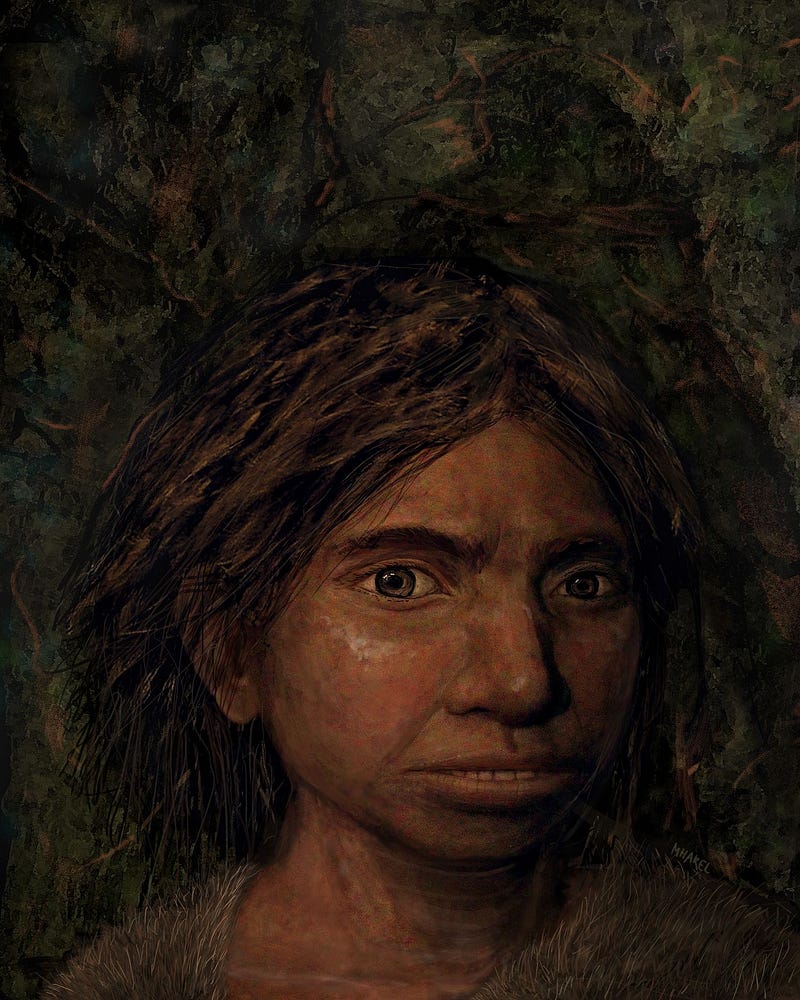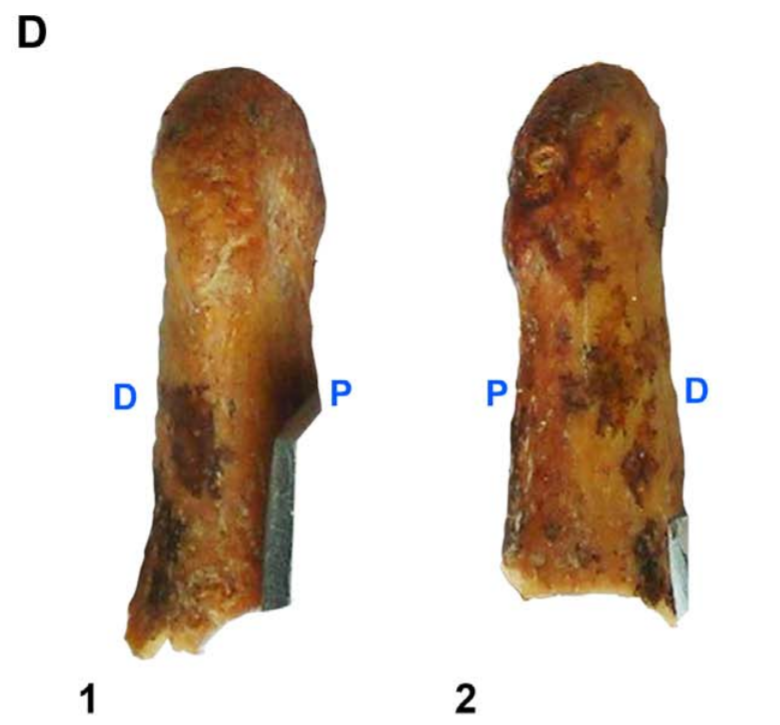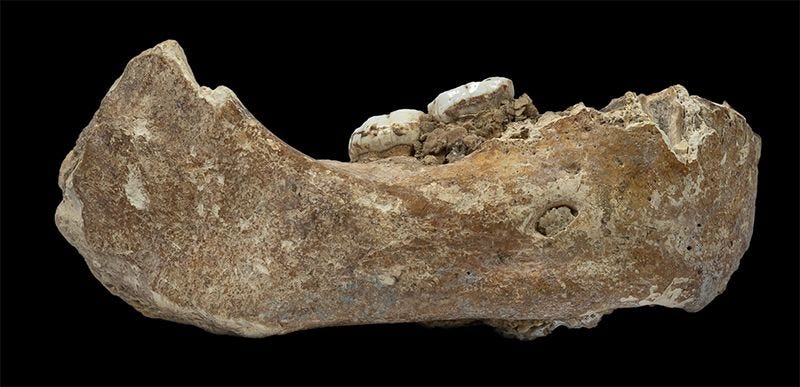New Discoveries Reveal Details About Early Humans
Who are the Denisovans? A branch of humankind contemporary with our early Modern Human ancestors and the Neanderthals has gone from unknown to new sensation, with scientific and archaeological discoveries in the headlines each week.
Breakthroughs in applied genetics and other new technologies are giving archaeologists futuristic tools for examining our distant past. They’re using them to learn as much as they can about these newly discovered ancient humans — and about ourselves — as we have discovered traces of Denisovan DNA within our own Modern Human genome. As we’ve also discovered with Neanderthals, Denisovans significantly interbred with Ancient Modern Humans, and their genetic signs can be seen in different populations living today.
The Denisovans’ story begins in the Altai Mountains of Siberia. In the funky way things get named, these newly discovered ancient humans are identified by the mountain cave their remains were discovered in, Denisova Cave, called that thanks to one of the cave’s final residents a couple hundred years ago, a hermit named Denis[i]. They’re “Denisovans” simply because they were found in Denis’ old place in 2010. Which was really their old place some 200,000 or so years earlier.

One of the more sensational “finds” of late claimed to show us what a Denisovan looked like[ii]. Scientists used a complex genetic testing method to determine how genes in Denisovan DNA may have been expressed in their physical features. Other scientists and archaeologists were skeptical of these somewhat speculative results, however.[iii]
After discovering there was such a thing as Denisovan DNA, we began to find some Modern Humans possessed the remnants of Denisovan DNA within our own. Just this week, additional genetic evidence emerged from Melanesia, as researchers found more inherited genetic markers from Denisovans in modern Melanesian DNA, which likely remained a part of the genome this long due to providing some benefit to their immune systems, diet, cellular function or metabolism.[iv]
What more have we discovered about these Denisovans? We’ve developed an amazing amount of knowledge in the last nine years, much of it from a pinky bone found in that cave.
The Denisova Cave in the Altai Mountains in southern Siberia, near the borders with Kazakhstan, Mongolia and China, has been an archaeological site since the 1990’s, yielding Neanderthal, modern human and other remains.

In 2010, archaeologists discovered some of the “other” remains — a finger bone and three molars — belonged to another, as yet undocumented group, which they designated Homo Denisova. Researchers “extracted DNA from all four Denisovan fossils and determined that the specimens came from different individuals. Based on accumulated genetic differences among them, two of the individuals lived roughly 65,000 years before the others; the Denisovan lineage was around for quite some time.”[v]
The first Denisovans were there “as early as 195,000 years ago (at 95.4% probability). All Neanderthal fossils — as well as Denisova 11, the daughter of a Neanderthal and a Denisovan — date to between 80,000 and 140,000 years ago. The youngest Denisovan dates to 52,000–76,000 years ago.”[vi]
The Denisovans had big teeth, and a large jaw. The molars were quite large, leading some to speculate that the Denisovans were much larger than modern humans, perhaps a “giant” race. Recent discoveries have reinforced this view:
“A picture of the Denisovans has grown clearer. Everything about their heads seems to have been big, from their giant molars to their thick jaws to their massive brain cases. …Adults may have weighed well over 200 pounds… very large and robust individuals. …like football players.”[vii]
They might be giants.
For a long time, the original cave was the only place where Denisovan remains were discovered, though their genetic sequences were found “in populations from East and South Asia and Papuans.” Where the Neanderthals seemed to have left Africa and ranged across Europe, the Denisovans went the other way.
We know this thanks to their genetic traces in modern humans living today:
“As a result of ancient interbreeding, people living today on islands of Southeast Asia and Oceania have genomes with up to 6 percent Denisovan DNA. Some mainland East Asians also show a trace — less than 1 percent… This suggests that Denisovans moved about Asia, surviving in environments from the mountains of Siberia to the tropics of Australasia.”[viii]
They found two kinds of Denisovan ancestry with “differing similarity to the sequenced Altai Denisovan individual.” That means there were at least two different times that humans and Denisovans interbred, with two different Denisovan groups, evident because of their different genetic “levels of relatedness to the sequenced Altai Denisovan.”[ix]
This past spring, researchers shared evidence for Denisovan and human interbreeding as far afield as New Guinea, identifying three different groups of Denisovans who mated with modern humans.[x] Researchers have even “identified DNA that looks to be Denisovan in Inuit people from Greenland. The sequence contains genes related to body fat distribution, important for surviving the cold.”[xi]
Most of the science and DNA work were based on the Denisovan remains found in Denisova Cave. It wasn’t until earlier this year that more physical Denisovan remains were identified away from the cave.

A jawbone found in 1980 in Baishiya Karst Cave in distant Tibet by a Buddhist monk was discovered to be Denisovan. The first “direct evidence of the Denisovans outside the Altai Mountains”. Analysis of the jawbone’s discovery “indicate(s) that archaic hominins occupied the Tibetan Plateau in the Middle Pleistocene epoch and successfully adapted to high-altitude hypoxic environments long before the regional arrival of modern Homo sapiens.”[xii]
“The altitude of the new Denisovan’s home — 3,280 metres above sea level — surprised researchers, and helps to solve a mystery about Denisovans’ genetic contribution to modern Tibetans… Some Tibetans have a variant of a gene called EPAS1 that reduces the amount of the oxygen-carrying protein haemoglobin in their blood, enabling them to live at high altitudes with low oxygen levels. Researchers had thought that this adaptation came from Denisovans, but this was difficult to reconcile with Denisova Cave’s relatively low altitude of 700 metres. The latest study suggests that Denisovans evolved the adaptation on the Tibetan Plateau and passed it to Homo sapiens when the species arrived around 30,000–40,000 years ago… If Denisovans in Asia were adapted to high altitudes, similar sites could harbour more of their remains.”[xiii]
Additional Denisovan remains may have already been discovered, but not yet identified. The protein analysis used in the latest study could provide clues in other cases where bones have been found, but no DNA was present.
The original Denisova cave continues to yield secrets. We’ve recently found the Denisovans had fingers more like modern humans, and less like the Neanderthal. The original finger bone discovered was digitally reconstructed and analyzed, revealing the Denisovans’ had human-like fingers.[xiv]
And sifting through the dirt and remains that piled up over the millennia inside the cave has recently helped archaeologists map out the cave’s residencies, Denisovan, Neanderthal and human, but — mostly — they discovered the cave was used by animals.
As Mike Morley, an archaeologist at Flinders University and the lead author of the new study told Gizmodo, “ “Basically, the story that we are telling is full of s***.” Yes, and bits of charcoal and bone fragments, as well. Thanks to the new study, we now have a better understanding of when the different groups lived there.[xv]
DNA study — genome analysis — of another bone fragment from the cave revealed a first generation Neanderthal/Denisovan hybrid,
“An individual who had a Neanderthal mother and a Denisovan father. The father, whose genome bears traces of Neanderthal ancestry, came from a population related to a later Denisovan found in the cave.
The mother came from a population more closely related to Neanderthals who lived later in Europe than to an earlier Neanderthal found in Denisova Cave, suggesting that migrations of Neanderthals between eastern and western Eurasia occurred sometime after 120,000 years ago. The finding of a first-generation Neanderthal–Denisovan offspring among the small number of archaic specimens sequenced to date suggests that mixing between Late Pleistocene hominin groups was common when they met.”[xvi]
Seems our ancestors got along. Quite well. We had no idea until recently how often Denisovans, Neanderthals, and Ancient Modern Humans interbred.
The Denisovans may have been artists as well. In July, researchers reported finding etchings on a bone from the Lingjing site in Henan Province, China, dated to 105–125,000 years ago. The site has tentatively been identified as Denisovan:
“The carefully engraved nature of the incisions, made on weathered rib fragments, precludes the possibility of unintentional or utilitarian origins. Residue analysis demonstrates the presence of ochre within the incised lines on one specimen. This research provides the first evidence for the deliberate use of ochred engravings for symbolic purposes by East Asian Late Pleistocene hominins.”[xvii]
It would also be the first example found of abstract, artistic thinking by the Denisovans, comparable to the Neanderthal cave paintings.
The pace of Denisovan discoveries is remarkable. We’ve learned so much about them in just under a decade. There is undoubtedly a lot left to learn. And, with new studies underway all the time, what we think we know may change, too. It will be fascinating to find out just how much we owe to this recently discovered forebear, our emerging ancestors, the Denisovans.
[i] New Studies Reveal the History of Denisova Cave, By Nicola Jones. The Leaky Foundation. February 1, 2019. https://leakeyfoundation.org/new-studies-denisova-cave/.
[ii] Ancient DNA puts a face on the mysterious Denisovans, extinct cousins of Neanderthals, By Michael Price. Science, Sep. 19, 2019. https://www.sciencemag.org/news/2019/09/ancient-dna-puts-face-mysterious-denisovans-extinct-cousins-neanderthals.
[iii] This is almost certainly not what Denisovans looked like, by Michael LePage, New Scientist, September,19 2019. https://www.newscientist.com/article/2216875-this-is-almost-certainly-not-what-denisovans-looked-like/.
[iv] Adaptive archaic introgression of copy number variants and the discovery of previously unknown human genes, PingHsun Hsieh, et al. Science 18 Oct 2019: Vol. 366, Issue 6463, eaax2083 DOI: 10.1126/science.aax2083. https://science.sciencemag.org/content/366/6463/eaax2083.
[v] Meet the Denisovans: Genomic research is writing the story of our most enigmatic cousins, by Bridget Alex. Discover Magazine, November 04, 2016. http://discovermagazine.com/2016/dec/meet-the-denisovans.
[vi] Age estimates for hominin fossils and the onset of the Upper Palaeolithic at Denisova Cave, Katerina Douka et al. Nature, Volume 565, pages 640–644. 30 January 2019. https://www.nature.com/articles/s41586-018-0870-z.
[vii] Denisovan Jawbone Discovered in a Cave in Tibet, by Carl Zimmer, New York Times, May 1, 2019. https://www.nytimes.com/2019/05/01/science/denisovans-tibet-jawbone-dna.html.
[viii] Meet the Denisovans, Alex, Discover. As above.
[ix] Analysis of Human Sequence Data Reveals Two Pulses of Archaic Denisovan Admixture, Browning SR, Browning BL, Zhou Y, Tucci S, Akey JM, Cell. Mar 22, 2018, 173(1):53–61.e9. Epub 2018 Mar 15. https://www.ncbi.nlm.nih.gov/pubmed/29551270?dopt=Abstract.
[x] Multiple Deeply Divergent Denisovan Ancestries in Papuans, Guy S. Jacobs et al. Cell, Volume 177, Issue 4, P1010–1021.E32, May 02, 2019. Published: April 10, 2019. https://doi.org/10.1016/J.CELL.2019.02.035.
[xi] Ibid.
[xii] A late Middle Pleistocene Denisovan mandible from the Tibetan Plateau, by Fahu Chen et al. Nature, 01 May 2019. https://www.nature.com/articles/s41586-019-1139-x.
[xiii] Biggest Denisovan fossil yet spills ancient human’s secrets — Jawbone from China reveals that the ancient human was widespread across the world — and lived at surprising altitude. by Matthew Warren, Nature, News. May 01, 2019. https://www.nature.com/articles/d41586-019-01395-0.
[xiv] Morphology of the Denisovan phalanx closer to modern humans than to Neanderthals, by E. Andrew Bennett et al. Science Advances, 04 Sep 2019: Vol. 5, no. 9. https://advances.sciencemag.org/content/5/9/eaaw3950.
[xv] Archaeologists Are Learning More About Who and What Lived in This Famous Siberian Cave, by George Dvorsky, Gizmodo, September 26, 2019. https://gizmodo.com/archaeologists-are-learning-more-about-who-and-what-liv-1838454833.
[xvi] The genome of the offspring of a Neanderthal mother and a Denisovan father, by Viviane Slon et al. Nature, Volume 561, pages 113–116, 22 August 2018. https://www.nature.com/articles/s41586-018-0455-x.
[xvii] Engraved bones from the archaic hominin site of Lingjing, Henan Province, Zhanyang Li et al. Antiquity, Volume 93, Issue 370, August 2019 , pp. 886–900. Published online by Cambridge University Press: 08 July 2019. https://www.cambridge.org/core/journals/antiquity/article/engraved-bones-from-the-archaic-hominin-site-of-lingjing-henan-province/8276D7FB70BFCBABF3AD716228158122/core-reader#.



